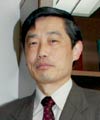—After establishing the NGN as a pillar of its Medium-Term Management Strategy in 2004, the NTT Group is working with both the domestic and foreign information-communications industry on NGN development. As the platform network of the future, the NGN is raising very high expectations. Why all the interest in NGN at this point in time?
Today, as broadband access and Internet-based services continue to expand, the network must be reconstructed from its very foundation to meet the ever-growing information-communication needs of society. This is the first and foremost reason for the NGN. Next, from a facilities point of view, the time for upgrading the entire telephone network has come. Moreover, with overseas telecommunications operators all participating in NGN development, NTT must adapt to the times and promote NGN R&D as both a world leader and a collaborative partner. Finally, from a business point of view, there is a desire to create new profit structures through the provision of broadband, Internet, and ubiquitous services. Thus, the NGN is something that we cannot do without.
Creating new content together with users
—Current NGN plans appear to emphasize hardware at the expense of content. How do you see content developing in the future?
The coming of the NGN will mean a dramatic leap in "peace of mind" in terms of security and protection from viruses. It will also mean, for example, the ability to view video programs without interruptions, and after some improvements have been made to the current NGN protocol, the ability to predict the actual time required for file transfers and downloads. From the user's point of view, these advances are very appealing, and providing such capabilities via the NGN is something that I really want to accomplish. Once these features become a reality, I think that users will naturally come up with many ideas in response to various needs and proceed to create content. Therefore, I can see myself thinking about new content together with users. In this regard, we began field trials last year that included the participation of other companies.
—Could you tell us about some of the group's achievements to date and specific research topics?
I am very pleased to see that the number of subscribers to FTTH (fiber to the home), which we have been working on for many years, has overtaken that of ADSL (asymmetric digital subscriber line). One important technology underlying FTTH is GE-PON (gigabit Ethernet passive optical network), which makes Ethernet—a widely used transmission protocol in offices and factories—not only faster but also compatible with optical access. GE-PON technology helps to increase the cost effectiveness and capacity of FTTH services. Also, as an example of important hardware-related technology, we are working on a system called Network Behavior Anomaly Detection (NBAD) that we expect to be a landmark achievement in defending against attacks on servers. In addition to the above, we are setting up large-scale, comprehensive testing facilities within our laboratories that are extensive enough for testing NGN functions and services.
Formation of a young researchers committee spanning three laboratory groups
—Mr. Okada, what is the atmosphere like inside NTT Laboratories today and what are your expectations for the future?
Well, to begin with, everyone is working very hard on a difficult schedule. We can expect peak work in NGN development to continue for at least one more year. But during this time, I would like to have researchers keep their next objective in mind. With the aim of creating a mechanism for this, we have formed an organization called the Young Researchers Committee that spans all three laboratory groups. This committee is engaged in various useful activities including idea contests.
Two years ago, one of our researchers, who was only in his late 20s, assumed the position of chairman of L1VPN (layer 1 virtual private network) WG, one of the working groups involved in the preparation of IETF (Internet Engineering Task Force) standards. There are now a lot of young people playing active roles in top positions around the world, and I hope that the development of talented people at NTT Laboratories will continue unabated. I also expect female researchers to become more involved, and I recognize the need to put NTT Laboratories on a path toward increasing the number of women in research. In the future, as we come to consider various new network services, I believe that the sensitivities that women can bring to research will become increasingly important.
—Fundamental research at NTT is performed by three laboratory groups. What are the features of each and what is the particular role of your laboratory group?
To put it quite simply, the Information Sharing Laboratory Group is in charge of the network. It researches and develops technologies and products that will become the foundation of the NGN. The Cyber Communications Laboratory Group is in charge of applications (content) and terminals. On the other hand, the Science and Core Technology Laboratory Group develops technologies with a 5- to 10-year outlook. These three laboratory groups research and develop technologies while cooperating with each other based on an R&D vision (Fig. 1).
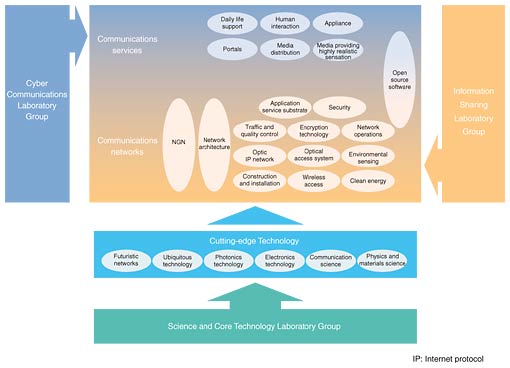
Fig. 1. Relationships among the three NTT Laboratory Groups.
Honored by Musashino City for a high recycling rate
—How do you contribute to the local community?
We are actually quite active. At the Musashino R&D Center where our laboratories are located, we clean up areas around the Center during our lunch break under a program called Clean Strategy. We also participate in Musashino City's cherry blossom festival, in the fire department's events, and in other local events. By the way, we were recently honored by Musashino City for having a very high recycling rate for the waste produced by the Center. Of course, it is only natural as a corporate citizen of this city to be concerned about the environment, but we were still delighted to be recognized for our efforts.
—What field would you like to focus on in the coming years and what do you see for future research?
Well, our research is so varied that it would be hard to name just one field, but if I had to choose one from the area of core technologies, I would perhaps say "encryption." There is currently research at NTT Laboratories on an encryption scheme that could not be broken even by a quantum computer, which is expected be a hundred million times more powerful than existing computers. This is top-grade research of a world-class level. I can also see us playing an active role in developing non-network-related technologies that focus on key social problems such as the aging society, care giving and medical care, and environmental protection. In fact, we have already developed sensors and sensor network systems for measuring water pollution in rivers, pollen dispersal, ozone levels, and other environmental characteristics. It is good to see that byproducts of our research process can also make important contributions to society.
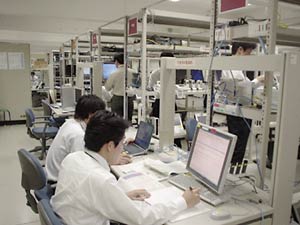
Photo 1. NGN testing activities.
In addition, NTT's efforts in the field of environmental information and communications technology (ICT) centered about the Environmental Management & Provisioning Project and the Energy and Environment Systems Laboratories are already beginning to produce results. One is the development of techniques for estimating macro-level reductions in energy consumption achieved by applying ICT. This achievement was cited in an environmental white paper issued by the Ministry of the Environment in 2006, which is something that we take great pride in. As a technology that can make a great contribution to reducing the environmental load in society, it's an area that we would like to continue focusing on in the years to come (Photo 1).
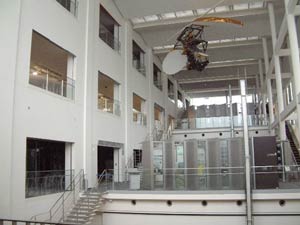
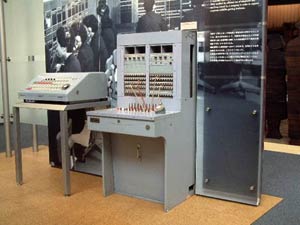

Photos 2, 3, and 4. NTT Telecommunication History Museum.
Focusing on the first half-century since the founding of Nippon Telegraph and Telephone Public Corporation, this museum presents the historical assets behind technology development in the NTT Group. Although not a public museum per se, its exhibits—which provide a systematic overview of the history of telecommunications technology in Japan—have received high praise from a wide range of visitors that include not only NTT Group employees but also customers of NTT Group companies, representatives of educational institutions, and local residents. The museum is open to the general public once a year during the Musashino Cherry Blossom Festival when the Musashino R&D Center also opens its grounds for cherry blossom viewing. On this day, the museum receives about 1000 visitors. In recent years, the museum has been increasingly used as part of the training for new employees of the various NTT Group companies.
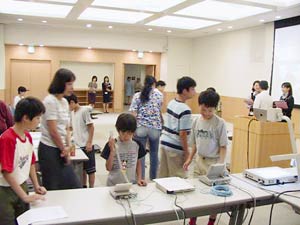
Photo 5. Exhibit hall.
The exhibit hall at the Musashino R&D Center brings together recent R&D achievements born of round-the-clock efforts at each of NTT's three laboratory groups. Here, visitors can touch and examine actual products and solutions (about 60 items) encompassing a wide range of advanced technologies enabling them to feel for themselves NTT Group's high level of expertise in developing technology and anticipating the needs of the times. The exhibit hall is normally open to just the NTT Group, but it also welcomes children, local residents, and other groups from time to time during events such as the Musashino Cherry Blossom Festival as part of our efforts to contribute to the community.
↑ TOP

